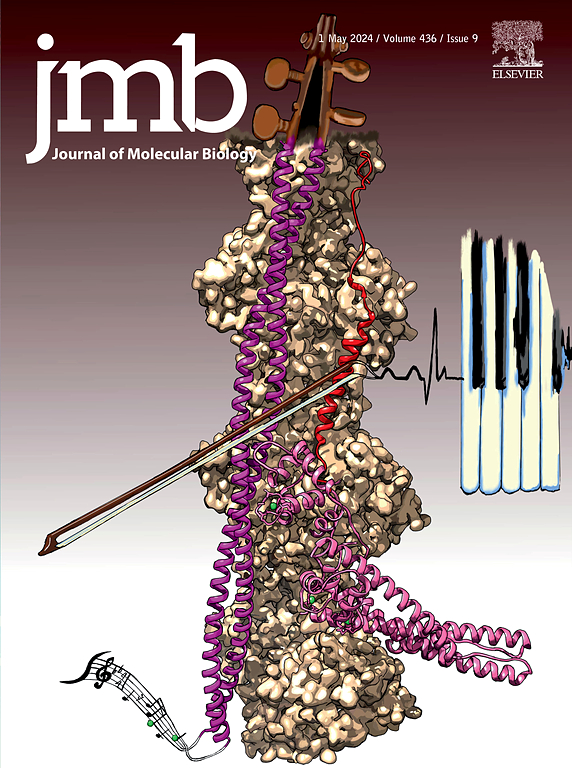Formation Mechanism and Antibacterial Activity of Natural Antimicrobial Lysozyme with Antibiotics Doxycycline and Tigecycline
IF 4.7
2区 生物学
Q1 BIOCHEMISTRY & MOLECULAR BIOLOGY
引用次数: 0
Abstract
The combination of lysozyme with antibiotics has emerged as a promising strategy to combat bacterial resistance; however, the lack of mechanistic understanding regarding their molecular-level interactions remains a critical knowledge gap, hindering the rational design of optimized synergistic therapies. Through integrated spectroscopic techniques (FTIR, CD, UV–vis, fluorescence), thermodynamic analyses, molecular docking, and 200-ns molecular dynamics simulation, we established that doxycycline/tigecycline bind lysozyme via moderate-affinity hydrophobic interactions (Ka ∼ 104 L mol−1) but with distinct binding patterns-tigecycline forms additional hydrogen bonds through its glycylamino side chain, yielding higher stability and lower free drug fraction (fu) compare to doxycycline. Additionally, doxycycline and tigecycline have a relatively mild effect on lysozyme conformation, but doxycycline has a greater impact on lysozyme conformation than tigecycline. Key findings reveal a paradoxical efficacy relationship: while doxycycline exhibits stronger intrinsic antibacterial activity, the lysozyme-tigecycline complex demonstrates synergistic enhancement (particularly against E. coli) through stable binding-mediated protection and optimized release kinetics, whereas lysozyme-doxycycline’s weaker binding leads to premature release and reduced activity. These results fundamentally advance protein-drug interaction paradigms by demonstrating that optimal therapeutic outcomes require balanced binding stability, with broader implications for designing lysozyme-based delivery systems where moderately strong interactions enable synergistic effects while preserving structural integrity, offering a template for developing combination therapies against antimicrobial resistance.

天然抗菌溶菌酶与多西环素、替加环素的形成机制及抑菌活性。
溶菌酶与抗生素的结合已成为对抗细菌耐药性的一种有前途的策略;然而,缺乏对它们分子水平相互作用的机制理解仍然是一个关键的知识缺口,阻碍了优化协同疗法的合理设计。通过综合光谱技术(FTIR、CD、UV-vis、荧光)、热力学分析、分子对接和200-ns分子动力学模拟,我们确定了多西环素/替加环素通过中亲和疏水相互作用(Ka ~ 104 L mol-1)与溶菌酶结合,但结合模式不同——替加环素通过其甘氨基侧链形成额外的氢键,与多西环素相比具有更高的稳定性和更低的游离药物组分(fu)。此外,强力霉素和替加环素对溶菌酶构象的影响相对温和,但强力霉素对溶菌酶构象的影响大于替加环素。关键发现揭示了一种矛盾的功效关系:强力霉素具有更强的内在抗菌活性,而溶菌酶-替加环素复合物通过稳定的结合介导保护和优化的释放动力学表现出协同增强(特别是对大肠杆菌),而溶菌酶-强力霉素较弱的结合导致过早释放和活性降低。这些结果从根本上推进了蛋白质-药物相互作用范式,证明了最佳治疗结果需要平衡的结合稳定性,这对设计基于溶菌酶的递送系统具有更广泛的意义,其中适度强的相互作用可以在保持结构完整性的同时实现协同效应,为开发针对抗菌素耐药性的联合疗法提供了模板。
本文章由计算机程序翻译,如有差异,请以英文原文为准。
求助全文
约1分钟内获得全文
求助全文
来源期刊

Journal of Molecular Biology
生物-生化与分子生物学
CiteScore
11.30
自引率
1.80%
发文量
412
审稿时长
28 days
期刊介绍:
Journal of Molecular Biology (JMB) provides high quality, comprehensive and broad coverage in all areas of molecular biology. The journal publishes original scientific research papers that provide mechanistic and functional insights and report a significant advance to the field. The journal encourages the submission of multidisciplinary studies that use complementary experimental and computational approaches to address challenging biological questions.
Research areas include but are not limited to: Biomolecular interactions, signaling networks, systems biology; Cell cycle, cell growth, cell differentiation; Cell death, autophagy; Cell signaling and regulation; Chemical biology; Computational biology, in combination with experimental studies; DNA replication, repair, and recombination; Development, regenerative biology, mechanistic and functional studies of stem cells; Epigenetics, chromatin structure and function; Gene expression; Membrane processes, cell surface proteins and cell-cell interactions; Methodological advances, both experimental and theoretical, including databases; Microbiology, virology, and interactions with the host or environment; Microbiota mechanistic and functional studies; Nuclear organization; Post-translational modifications, proteomics; Processing and function of biologically important macromolecules and complexes; Molecular basis of disease; RNA processing, structure and functions of non-coding RNAs, transcription; Sorting, spatiotemporal organization, trafficking; Structural biology; Synthetic biology; Translation, protein folding, chaperones, protein degradation and quality control.
 求助内容:
求助内容: 应助结果提醒方式:
应助结果提醒方式:


